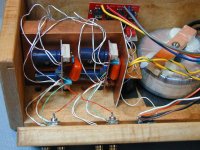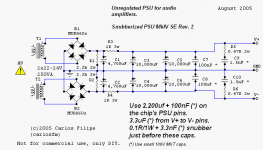GaryB said:I added all the bypass caps in stages and can report that the sound kept getting better as I added every component and only the full complement gave what I consider excellent sound
Yes, it is.
GaryB said:Right now I'd say that this is a truly excellent amp and compares very favorably to some very good amps.
Yes, it does.
Thanks for
 ing it and for reporting.😎
ing it and for reporting.😎Tried it, like it so far
Built one channel of the 3886 amp (clarisfm versions 3) with the snubberised PS (mark iv) and so far I find it to be:
1. In the highs, more delicate and resolved and listenable than the LM3875 NIGC that I currently use
2. More expressive and emotive in the mids
3. No comment on bass yet, but seems similar to the 3875
Amp is a couple of hours old, using a cheap 10k log pot (passive). I don;t have the time to read all the pre-amps posts-are there any souls kind enough to share their pre-amp experiences with this chip:
1. Is active better than passive?
2. What have you built-Any schematics?
3. Anyone tried the 627 or Ad815 op-amp pre-amps posted by carlosfm?
Will post further impressions after a week or so
Ryan
Built one channel of the 3886 amp (clarisfm versions 3) with the snubberised PS (mark iv) and so far I find it to be:
1. In the highs, more delicate and resolved and listenable than the LM3875 NIGC that I currently use
2. More expressive and emotive in the mids
3. No comment on bass yet, but seems similar to the 3875
Amp is a couple of hours old, using a cheap 10k log pot (passive). I don;t have the time to read all the pre-amps posts-are there any souls kind enough to share their pre-amp experiences with this chip:
1. Is active better than passive?
2. What have you built-Any schematics?
3. Anyone tried the 627 or Ad815 op-amp pre-amps posted by carlosfm?
Will post further impressions after a week or so
Ryan
An externally hosted image should be here but it was not working when we last tested it.
Is this the correct way to wire up the torroids on this PSU design?
Where did you get that schematic?😕
You can use two bridges and a dual independent secondaries trafo (each secondary connects to one bridge), or a center-tapped secondary and one bridge (the ground point is the CT of the trafo).
You can use two bridges and a dual independent secondaries trafo (each secondary connects to one bridge), or a center-tapped secondary and one bridge (the ground point is the CT of the trafo).
I guess what I am trying to do is use two transformers each with dual secondaries. I can't find a transformer in the voltage I need with a high enough VA, so I want to use two smaller VA dual secondary transformers. I have searched for some time now and keep coming up empty. I have heard that commercial amps do this, but can't figure out how to wire them up.
Carlos -- the 0.47R resistors see a power dissipation of:
P = 1/2 (C * V^2)
= C * f * V^2
where V is the ripple voltage
Since this isn't a switching supply (i.e. f = 100 or 120Hz for a full wave bridge) you don't need a 2 watt resistor at this location.
P = 1/2 (C * V^2)
= C * f * V^2
where V is the ripple voltage
Since this isn't a switching supply (i.e. f = 100 or 120Hz for a full wave bridge) you don't need a 2 watt resistor at this location.
We have covered this before but Carlos has never come up with any min specification in electrical terms. It's about microwatts.
Worst case ripple at 20 kHz how much can that be? Worst case with music, how much?
Worst case ripple at 20 kHz how much can that be? Worst case with music, how much?
moamps said:On the other side, R3 and R4 are underpowered, IMHO.
Yeah, should be at least 5W -- but I don't see any benefit to this version of a CRC filter anyway.
quote:
Originally posted by moamps
On the other side, R3 and R4 are underpowered, IMHO.
P= I*I*R
If you consider these 30 volt rails are feeding a 60 watt
amplifier then 1 Amp is on both rails.
This would require 1 watt= 1 ampx1ampx 1R
Given one does not drive a motor with the maximum load of the amplifier then 3 Waatts is more than sufficient.
Even trebling the amp power will still leave it at spec. also as the smaller filter cap is before the resistor there will be a levelling effect caused by the large downstream caps. This means the resistor does not even see the instantaneous peaks.
If you use the amp for music; typically the power required is on the order of 10% or less of max power.
So to net it out the resistor rating is/will be more than adequate.
Originally posted by moamps
On the other side, R3 and R4 are underpowered, IMHO.
P= I*I*R
If you consider these 30 volt rails are feeding a 60 watt
amplifier then 1 Amp is on both rails.
This would require 1 watt= 1 ampx1ampx 1R
Given one does not drive a motor with the maximum load of the amplifier then 3 Waatts is more than sufficient.
Even trebling the amp power will still leave it at spec. also as the smaller filter cap is before the resistor there will be a levelling effect caused by the large downstream caps. This means the resistor does not even see the instantaneous peaks.
If you use the amp for music; typically the power required is on the order of 10% or less of max power.
So to net it out the resistor rating is/will be more than adequate.
They are rated for 3 watts at 70 deg C surrounding temp and for music with 70 deg C hot inside the amp they might be enough despite that the LM3875 may deliver 7.5 amps. I'll guess they will burn if you have 100% output power but that's hardly music.moamps said:On the other side, R3 and R4 are underpowered, IMHO.
SheldonD said:quote:
Originally posted by moamps
On the other side, R3 and R4 are underpowered, IMHO.
P= I*I*R
If you consider these 30 volt rails are feeding a 60 watt
amplifier then 1 Amp is on both rails.
This would require 1 watt= 1 ampx1ampx 1R
Given one does not drive a motor with the maximum load of the amplifier then 3 Waatts is more than sufficient.
Even trebling the amp power will still leave it at spec. also as the smaller filter cap is before the resistor there will be a levelling effect caused by the large downstream caps. This means the resistor does not even see the instantaneous peaks.
If you use the amp for music; typically the power required is on the order of 10% or less of max power.
So to net it out the resistor rating is/will be more than adequate.
Actually, the chipamp power supply is going to consume more energy because all its efforts aren't all put into music! That's what the heatsink is for. Some of the energy is dissipated in the loudspeaker, some is wasted as heat. A 3W resistor will run hot in this application, reducing the MTBF.
I suggest that you measure the voltage drop across the resistor at full output power -- i.e. with a 1kHz sine wave, 1.47V.
If you work the PdMAX equations backwards from National Semi's website you will quickly see what I mean.
jackinnj said:Actually, the chipamp power supply is going to consume more energy because all its efforts aren't all put into music! That's what the heatsink is for. Some of the energy is dissipated in the loudspeaker, some is wasted as heat. A 3W resistor will run hot in this application, reducing the MTBF.
I suggest that you measure the voltage drop across the resistor at full output power -- i.e. with a 1kHz sine wave, 1.47V.
If you work the PdMAX equations backwards from National Semi's website you will quickly see what I mean.
It doesn't get hot at all, even pushing the amp.
And this is for this PSU feeding two chips.
But let me ask you something: do you really design for full power, at 4 ohms?
What kind of trafos do you use, 1000VA?
Well, I actually use around 30,000uf capacitance per rail after those series resistors and the amp floats.😀
It takes some 10 seconds to shut down after switch-off, even with those bleeder resistors.
The trafo is not big, it's around 200VA.
This works much better than a huge trafo and 1,500uf capacitance per rail.
I did pick 3W resistors because that's the maximum I had in carbon, as I didn't want to use wirewounds.
But actually, wirewound resistors in series with the voltage rails make no harm, so yes, it could be used 5~7W wirewound resistors there.
I just didn't see any need to use more than 3W.
- Status
- Not open for further replies.
- Home
- Amplifiers
- Chip Amps
- The (high-cap.) unregulated PSU for chipamps



